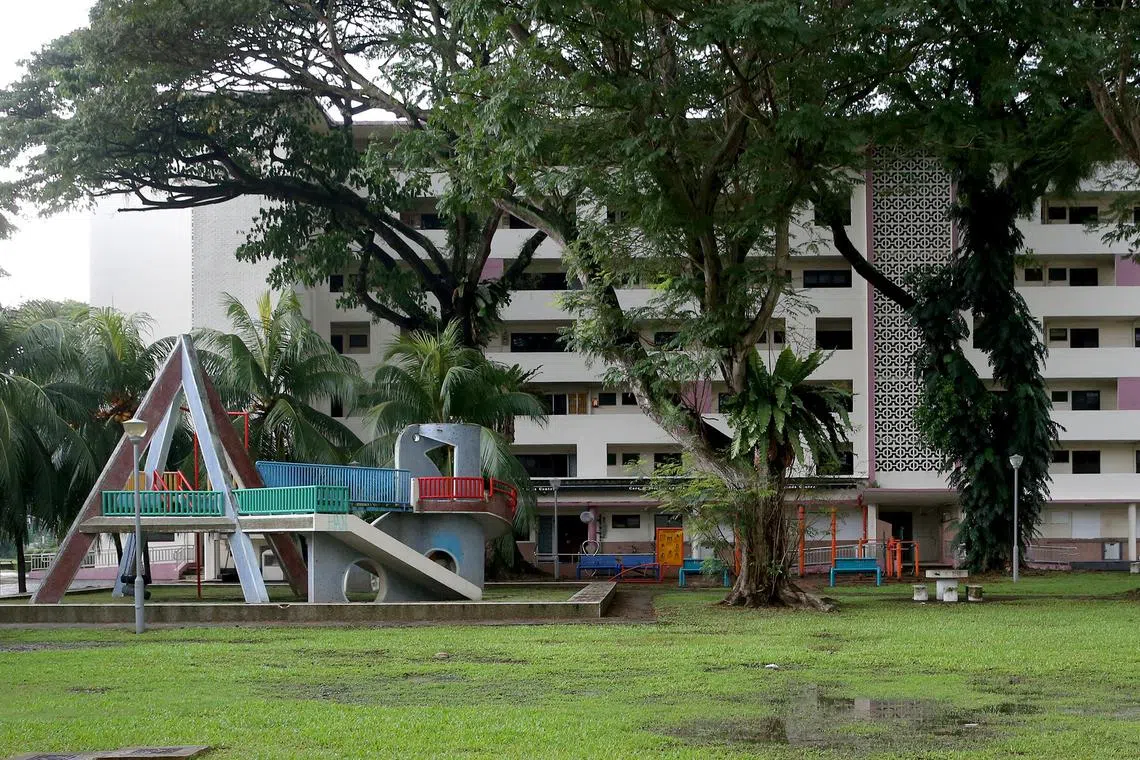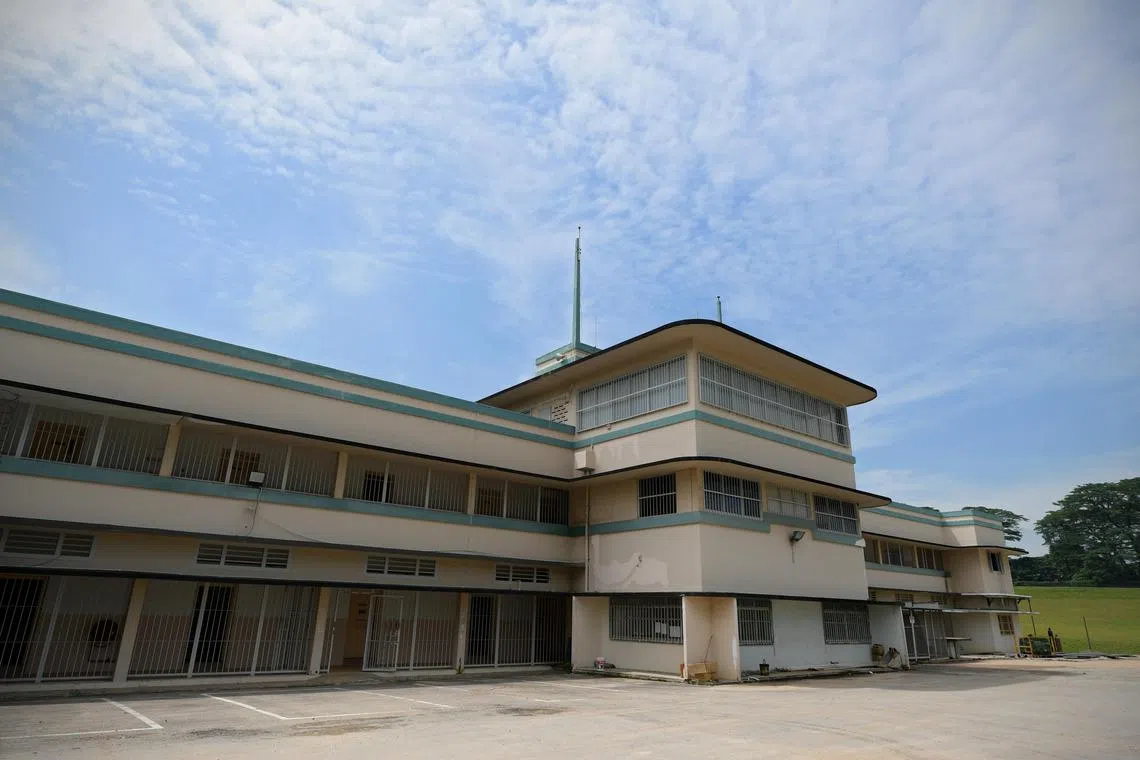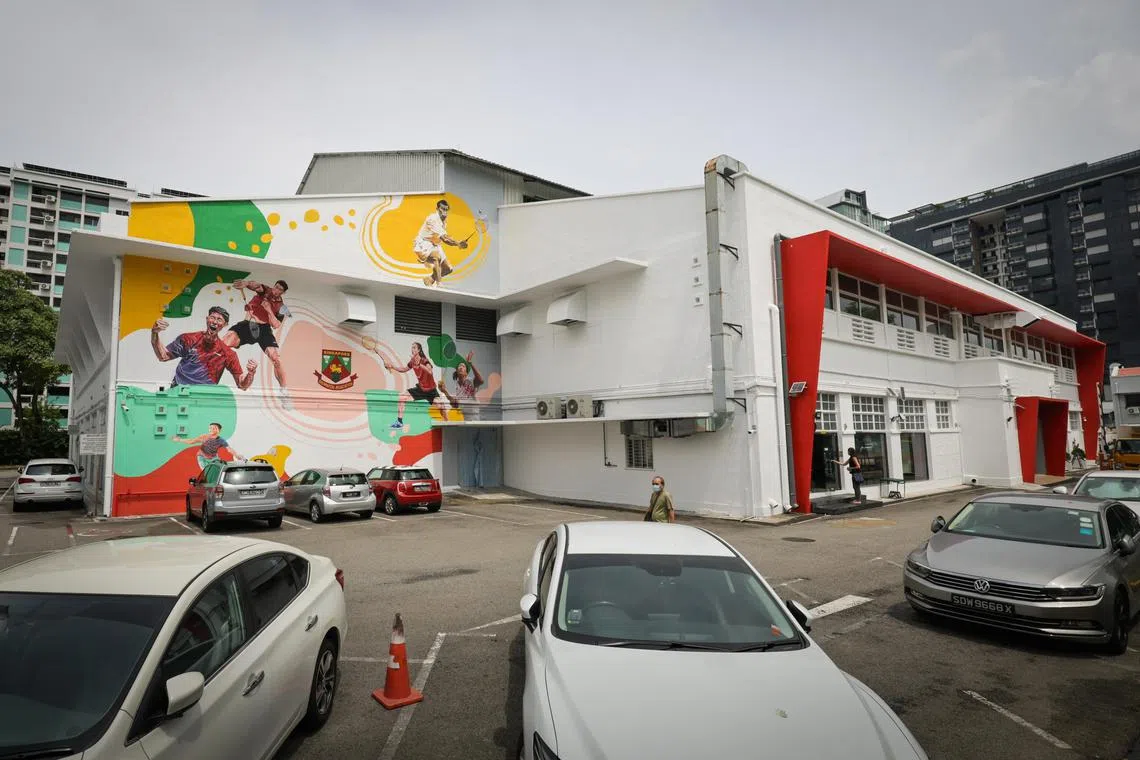Jurong Hill Tower, Turf City grandstands and Dakota Crescent blocks to be conserved
Sign up now: Get ST's newsletters delivered to your inbox

(Clockwise) Jurong Hill Tower, the Dakota Crescent estate, the Singapore Badminton Hall, the former Royal Malayan Navy admin block and the grandstands at Turf City have been put forth for conservation.
PHOTOS: ST FILE
Follow topic:
SINGAPORE – Jurong Hill Tower, two grandstands at Turf City in Bukit Timah and six blocks in Dakota Crescent estate have been put forth for conservation.
The state properties were among buildings and structures at five sites that National Development Minister Desmond Lee said the Urban Redevelopment Authority (URA) is proposing to conserve.
The two other sites are the former Royal Malayan Navy administrative block in Woodlands North and the Singapore Badminton Hall at 100 Guillemard Road.
In a video posted on Facebook on May 14, Mr Lee said the buildings and sites helped tell the story of Singapore’s progress in the past 60 years.
“Each one means something to someone,” he said, adding that “one important way of anchoring our sense of place and identity as Singaporeans is to conserve buildings and sites that reflect our common history and experiences”.
Citing Jurong Hill Tower, which was built in 1969 by JTC Corporation as a lookout point, Mr Lee said it was a symbol of independent Singapore’s industrial transformation, and signalled the country’s economic ambitions.
He added that plans for the properties will be showcased at the Draft Master Plan 2025 exhibition, slated for June.
URA’s masterplan is a statutory document which guides Singapore’s development for the next 10 to 15 years, and is reviewed once every five years.
Safeguarding heritage and nature is one key focus area under the ongoing review, Mr Lee said. Beyond conservation, memories of the past can be recalled in other ways such as digital documentation, physical markers and walking trails, he added.
To date, more than 7,200 buildings and structures in over 100 areas have been conserved in Singapore.
Heritage blogger and author Jerome Lim cheered the decision to conserve the five sites, noting that three of them – Singapore Badminton Hall, the Dakota Crescent blocks, and the Royal Malayan Navy admin block – had their beginnings in the post-World War II, pre-independence period, which he said is “a phase of our history that seems lacking in representation”.
“It was a period marked by the development of the Malayan and Singapore identity as well as a rise of political awareness; a period that is also often neglected in the telling of Singapore’s political and social history,” he said.
Mr Lim added that more can, and should, be done to retain structures from that period and also the post-independence period, which he said is also under-represented.
“The periods saw buildings which played significant roles in Singapore’s development such as the former Pasir Panjang ‘A’ Power Station and the Paya Lebar Airport’s passenger terminal and control tower,” he said.
Mr Ho Weng Hin, the founder of heritage non-profit Docomomo Singapore, said he was encouraged that different types of buildings representing different threads of early Singapore history are up for conservation, but noted that all of these belong to the state.
He said that more can be done to incentivise owners of privately owned buildings, that were also part of the Singapore story, to retain them.
While Jurong Hill Tower represents Singapore’s industrial past, there are other buildings in private hands, such as the National Iron and Steel Mills office (now NatSteel), from the 1960s that are important in their own right, and have yet to be protected.
He said that as more brownfield sites are redeveloped, the authorities should roll out a systematic framework to consider buildings for reuse instead of just redevelopment.
Jurong Hill Tower

Jurong Hill Tower pictured in 2022.
PHOTO: ST FILE
Located within Jurong Hill Park, the tower offers visitors panoramic views of Jurong Industrial Estate.
It was a popular stop for foreign heads of state and dignitaries visiting the estate between 1969 and 1984.
During these tours, some foreign dignitaries would plant trees at the park’s Garden of Fame – located at the foot of the tower – to commemorate their visits.
URA said the garden and the tower were valued as a recreational destination for locals, and symbolised Singapore’s close ties with other countries, which helped draw foreign investors in the country’s early years of independence.
In October 2024, URA and JTC launched a competition to seek ideas
Results of the competition, which closed in January, have not been publicly announced.
Mr Lim said that the park has “suffered from poor accessibility, a lack of pulling power and perhaps some level of neglect”.
He hopes the rejuvenated park “continues to be a green place in the grey industrial west, maybe with hiking trails that could incorporate some sections of Jurong’s industrial story”.
Turf City grandstands

The South Grandstand (left) and the North Grandstand (right) of the former Turf City, pictured in 2022.
PHOTO: ST FILE
The 1933-built South Grandstand and the 1981-built North Grandstand of the former Turf City in Bukit Timah will become part of the civic and recreational heart of a future housing precinct, which will have up to 20,000 new homes.
Turf City was Singapore’s second racecourse from 1933 to 1999, and became a recreational and commercial hub after the Singapore Turf Club relocated to Kranji.
URA said the two grandstands are “tangible reminders of the development of horse racing as a popular spectator sport and reflect Singapore’s journey from colonial to post-independence periods”.
To pay homage to the site’s sporting heritage, a central open space will be retained in front of the grandstands and be dedicated to sports and recreational uses, as part of the upcoming housing precinct.
URA had announced in May 2024 that it will study the two grandstands, along with 25 other structures and buildings, for potential retention in the Bukit Timah Turf City estate.
On May 14, URA said it will share more details on the potential retention and adaptive reuse of the 25 other buildings and structures – the former Secretaries’ Bungalows and Bukit Timah Saddle Club Clubhouse – when ready.
Dr Yeo Kang Shua, the vice-president of the International Council on Monuments and Sites Singapore, said that the two grandstands, as large structures, may require a public agency to operate, as leaving a private operator and market forces to manage the building might not achieve “thoughtful reuse”.
Given that the grandstands are slated to be part of the area’s community hub, Dr Yeo said that future operators can look to Our Tampines Hub, an integrated community and lifestyle centre, as an example of how to adapt the conserved structures for use as community facilities.
Dakota Crescent blocks

Dakota Crescent estate’s iconic Dove playground (left), pictured in 2017.
PHOTO: ST FILE
One of Singapore’s oldest public housing estates, Dakota Crescent, in Mountbatten, was built by the Singapore Improvement Trust in 1958 to address overcrowding in the city centre.
The estate was characterised by its distinctive low-rise blocks, which included a variety of two-, three- and seven-storey blocks.
A decision to redevelop the estate that was announced in 2015 drew pushback from architects and residents, who wanted the blocks in the estate retained for their architectural merit.
The seven-storey blocks, for instance, have a curved footprint, likened to the shape of a butterfly, as well as distinctive balconies that protrude from the building’s facade.

Some of the balconies of Dakota Crescent’s seven-storey blocks protrude from the building’s facade.
PHOTO: URBAN REDEVELOPMENT AUTHORITY
In 2017, then National Development Minister Lawrence Wong announced that the estate would be redeveloped for public housing, but that six blocks – the ones now slated for conservation – would be retained for civic and community uses.
Former Royal Malayan Naval Base admin block

The former Royal Malayan Navy (RMN) admin block, which will be put up for conservation.
PHOTO: ST FILE
Completed in 1953, the admin block captures seven decades of naval history, spanning the colonial and post-independence eras in Singapore.
The naval base was used to train locals recruited by the British in the 1950s, those serving Malaya after the British handed the Malayan Navy over to the Malayan government in 1957, and then recruits of the Malaysian Navy after Singapore gained independence in 1965.
After it was returned to Singapore in 1997, the site was repurposed as Admiralty West Prison from 2011 to 2018.
URA said the admin block reflects the architectural trends of its time and was designed in art deco style, with modern tropical elements such as streamlined rounded canopies.
The agency said in 2022 that the block is being retained as part of a future housing development at the site.
The former naval base’s other buildings have since been demolished.
Singapore Badminton Hall

The former Singapore Badminton Hall at 100 Guillemard Road pictured in July 2024.
PHOTO: ST FILE
Designed by pioneer Singaporean architect Ng Keng Siang, the hall was completed in June 1952.
It hosted the third Thomas Cup badminton tournament in 1955 and the fourth in 1958, and was where local badminton talents such as Wong Peng Soon, Ismail Marjan and Ong Poh Lim trained in the 1950s.
The hall also hosted competitions for other sports, including gymnastics, sepak takraw, table tennis, billiards and wrestling.
In 1962, the hall was used as a vote-counting venue in the referendum to merge Singapore, Brunei, Sarawak, Sabah and the Federation of Malay States to form Malaysia.
URA said the hall is set to be conserved “as a symbol of Singapore’s humble beginnings and to mark historic moments in the local sports scene and our nation’s evolution”.
The hall retains its original use, with nine courts in its 1,300-seater hall at 100 Guillemard Road available for public and corporate bookings.
It is operated by a subsidiary of the Singapore Badminton Association, which leased the building from the Singapore Land Authority in 2023.
Mr Ho said that while the Singapore Badminton Hall may not be renowned for its architectural merits, its social and historical significance stand out, with athletes who trained and competed there helping to put Singapore on the world stage. It was, for instance, where Wong Shoon Keat won Singapore’s first men’s singles badminton gold at the Southeast Asian Games in 1983.
Ng Keng Gene is a correspondent at The Straits Times, reporting on issues relating to land use, urban planning and heritage.


